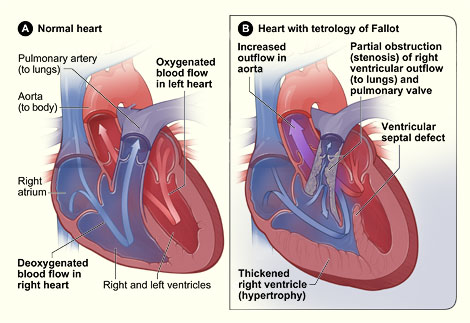What Is Tetralogy of Fallot?
Tetralogy of Fallot is a
congenital
(kon-JEN-i-tal) heart defect (a problem with the heart's structure that's
present at birth). Congenital heart defects change the normal flow of blood
through the heart. This rare and complex heart defect occurs in about
5 out every 10,000 babies. It affects boys and girls equally.
Tetralogy of Fallot involves four defects:
Ventricular Septal Defect
The heart has a wall that separates the chambers on
its left side from those on its right side. This wall is called a septum. The
septum prevents blood from mixing between the two sides of the heart.
A VSD is a hole in the part of the septum that
separates the ventricles—the lower chambers of the heart. The hole allows
oxygen‑rich blood to flow from the left ventricle into the right
ventricle instead of flowing into the aorta, the main artery leading out to the
body.
Pulmonary Stenosis
This is a narrowing of the pulmonary valve and the
passageway through which blood flows from the right ventricle to the pulmonary
arteries. Normally, oxygen-poor blood from the right ventricle flows through
the pulmonary valve into the pulmonary arteries and out to the lungs to pick up
oxygen. In pulmonary stenosis, the heart has to work harder than normal to pump
blood, and not enough blood can get to the lungs.
Right Ventricular Hypertrophy
This is when the right ventricle thickens because
the heart has to pump harder than it should to move blood through the narrowed
pulmonary valve.
Overriding Aorta
This is a defect in the location of the aorta. In a
healthy heart, the aorta is attached to the left ventricle, allowing only
oxygen-rich blood to go to the body. In tetralogy of Fallot, the aorta is
between the left and right ventricles, directly over the VSD. As a result,
oxygen‑poor blood from the right ventricle can flow directly into the
aorta instead of into the pulmonary artery to the lungs.
Overview
Together, these four defects mean that not enough
blood is able to reach the lungs to get oxygen, and oxygen-poor blood flows out
to the body.
Normal Heart and Heart With
Tetralogy of Fallot

Figure A shows the normal structure
and blood flow in the interior of the heart. Figure B shows a heart with the
four defects of tetralogy of Fallot.
Babies and children with tetralogy of Fallot have
episodes of cyanosis (si-a-NO-sis), which is a bluish tint to the skin, lips,
and fingernails. Cyanosis occurs because the oxygen level in the blood is below
normal.
Tetralogy of Fallot must be repaired with
open‑heart surgery, either soon after birth or later in infancy. The
timing of the surgery depends on how severely the pulmonary valve is narrowed.
Outlook
Over the past few decades, the diagnosis and
treatment of tetralogy of Fallot has greatly improved. As a result, the
majority of children with this heart defect grow to adulthood. However, they
need lifelong medical care from a specialist to make sure they stay as healthy
as possible.
December 2007 |

